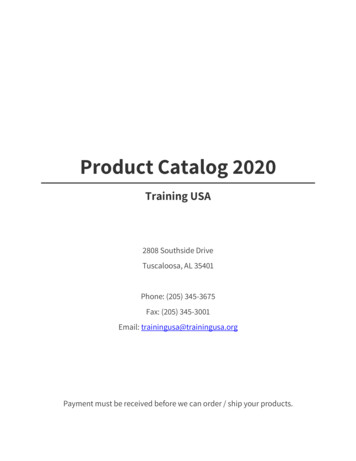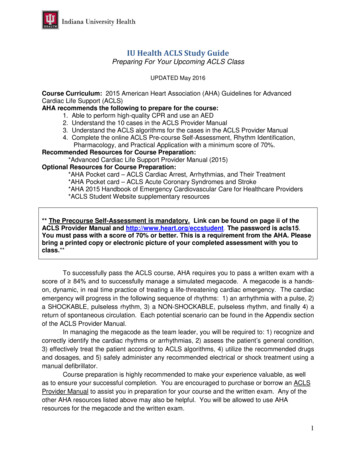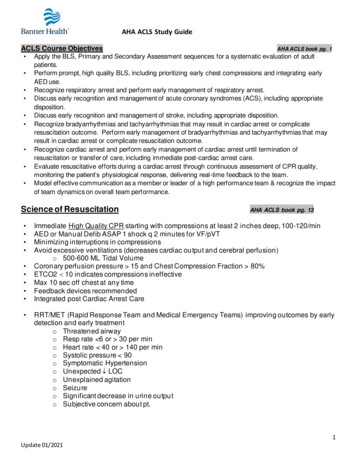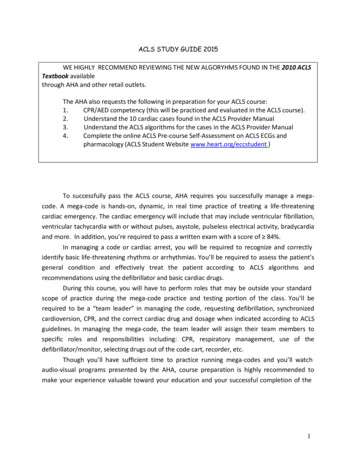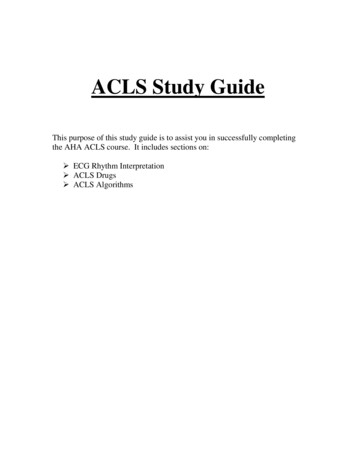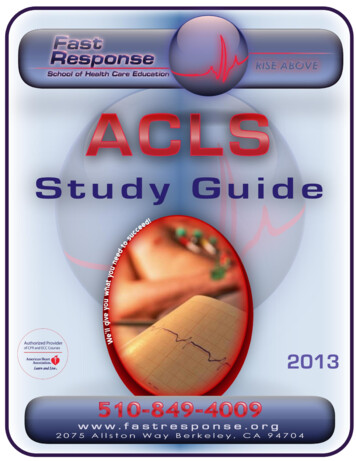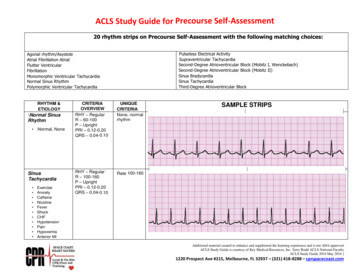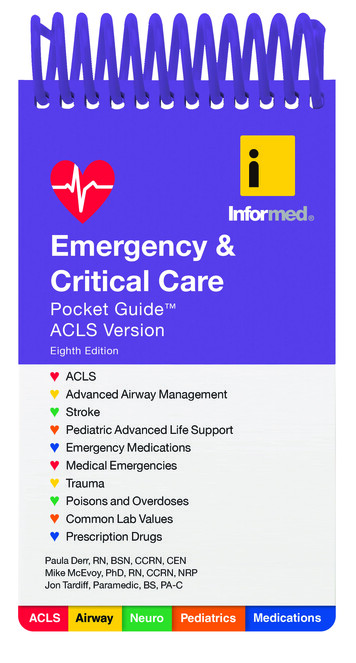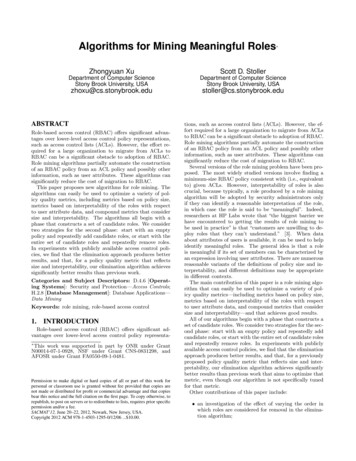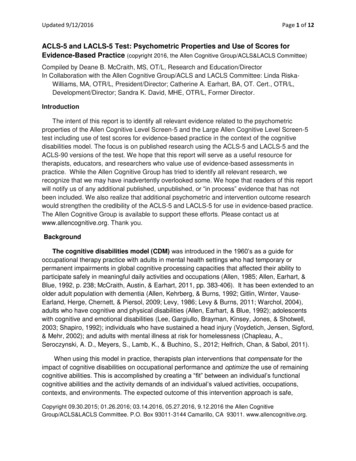
Transcription
Updated 9/12/2016Page 1 of 12ACLS-5 and LACLS-5 Test: Psychometric Properties and Use of Scores forEvidence-Based Practice (copyright 2016, the Allen Cognitive Group/ACLS&LACLS Committee)Compiled by Deane B. McCraith, MS, OT/L, Research and Education/DirectorIn Collaboration with the Allen Cognitive Group/ACLS and LACLS Committee: Linda RiskaWilliams, MA, OTR/L, President/Director; Catherine A. Earhart, BA, OT. Cert., OTR/L,Development/Director; Sandra K. David, MHE, OTR/L, Former Director.IntroductionThe intent of this report is to identify all relevant evidence related to the psychometricproperties of the Allen Cognitive Level Screen-5 and the Large Allen Cognitive Level Screen-5test including use of test scores for evidence-based practice in the context of the cognitivedisabilities model. The focus is on published research using the ACLS-5 and LACLS-5 and theACLS-90 versions of the test. We hope that this report will serve as a useful resource fortherapists, educators, and researchers who value use of evidence-based assessments inpractice. While the Allen Cognitive Group has tried to identify all relevant research, werecognize that we may have inadvertently overlooked some. We hope that readers of this reportwill notify us of any additional published, unpublished, or “in process” evidence that has notbeen included. We also realize that additional psychometric and intervention outcome researchwould strengthen the credibility of the ACLS-5 and LACLS-5 for use in evidence-based practice.The Allen Cognitive Group is available to support these efforts. Please contact us atwww.allencognitive.org. Thank you.BackgroundThe cognitive disabilities model (CDM) was introduced in the 1960’s as a guide foroccupational therapy practice with adults in mental health settings who had temporary orpermanent impairments in global cognitive processing capacities that affected their ability toparticipate safely in meaningful daily activities and occupations (Allen, 1985; Allen, Earhart, &Blue, 1992, p. 238; McCraith, Austin, & Earhart, 2011, pp. 383-406). It has been extended to anolder adult population with dementia (Allen, Kehrberg, & Burns, 1992; Gitlin, Winter, VauseEarland, Herge, Chernett, & Piersol, 2009; Levy, 1986; Levy & Burns, 2011; Warchol, 2004),adults who have cognitive and physical disabilities (Allen, Earhart, & Blue, 1992); adolescentswith cognitive and emotional disabilities (Lee, Gargiullo, Brayman, Kinsey, Jones, & Shotwell,2003; Shapiro, 1992); individuals who have sustained a head injury (Voydetich, Jensen, Sigford,& Mehr, 2002); and adults with mental illness at risk for homelessness (Chapleau, A.,Seroczynski, A. D., Meyers, S., Lamb, K., & Buchino, S., 2012; Helfrich, Chan, & Sabol, 2011).When using this model in practice, therapists plan interventions that compensate for theimpact of cognitive disabilities on occupational performance and optimize the use of remainingcognitive abilities. This is accomplished by creating a “fit” between an individual’s functionalcognitive abilities and the activity demands of an individual’s valued activities, occupations,contexts, and environments. The expected outcome of this intervention approach is safe,Copyright 09.30.2015; 01.26.2016; 03.14.2016, 05.27.2016, 9.12.2016 the Allen CognitiveGroup/ACLS&LACLS Committee. P.O. Box 93011-3144 Camarillo, CA 93011. www.allencognitive.org.
Updated 9/12/2016Page 2 of 12successful engagement and participation in valued activities and occupations in supportivecontexts and environments.The Allen Cognitive Level Screen (ACLS) and Large Allen Level Screen (LACLS) Testare two forms of a theory- and evidence-based, standardized screening test of functionalcognition designed to provide a quick estimate of cognitive abilities within cognitive levels 3, 4,and 5 on the Allen scale of levels and modes of performance. This scale is a 26-point scaleranging from 1.0 (low) – 6.0 (high) (Allen, Earhart, & Blue, 1992; McCraith, Austin, & Earhart,2011, pp. 388-391). The larger form of the assessment tool, the LACLS, is intended for use withindividuals who have impaired vision or hand function (Allen, Austin, David, Earhart, McCraith, &Riska-Williams, 2007; Kehrberg, Kuskowski, Mortimer, & Shoberg, 1992). Both forms provideopportunities to observe current global cognitive processing capacities related to 1) newlearning and problem solving abilities and 2) use of occupational performance skills. Theseabilities and skills are observed as they are applied in the performance of three stitching taskswith a set of carefully designed, standardized activity demands which increase in cognitivecomplexity from cognitive level/modes 3.0 to 5.8. As screens, these tools may be used todetect unknown or suspected problems in functional cognition or to identify potential cognitiveabilities. They are understood to provide an estimate of the severity of a problem or of retainedabilities at a given point in time (Allen, Earhart, & Blue, 1992; McCraith, Austin, & Earhart, 2011,pp. 383-406). Further assessment, preferably including observations of performance inmeaningful activities, is recommended to verify the screen score and to provide a more specificand complete understanding of an individual’s overall level of functional cognitive ability. TheAllen Diagnostic Module, 2nd edition (Earhart, 2006) and the Routine Task Inventory-E (Katz,2006) are two of the CDM-based assessments that have been developed for this purpose.The fifth version of the ACLS and the LACLS test is described in the Manual for the AllenCognitive Level Screen-5 (ACLS-5) and the Large Allen Cognitive Level Screen-5 (LACLS-5)(Allen, Austin, David, Earhart, McCraith, & Riska-Williams, 2007). This fifth version of themanual was undertaken in response to feedback from clinicians, educators, and researcherswho felt that a more professionalized manual with enhanced administration and scoringguidelines was needed to meet the clinical and scholarly expectations for “best practice.” Theenhancements and additions to the Manual for the 5th version are guided by the Standards forEducational and Psychological Testing (AERA, 1999). The enhancements include: Theoretical grounding of the test in the cognitive disabilities model for structure,administration, scoring, and guidelines for interpreting and reporting scores Standardized administration protocol including guidelines for providing cues andprompts Enhanced scoring tablesThe additions include: History and development of the ACLS and LACLS assessment tools and test Description of functional cognition as the theoretical construct measured Guidelines for interpreting and reporting scoresCopyright 09.30.2015; 01.26.2016; 03.14.2016, 05.27.2016, 9.12.2016 the Allen CognitiveGroup/ACLS&LACLS Committee. P.O. Box 93011-3144 Camarillo, CA 93011. www.allencognitive.org.
Updated 9/12/2016 Page 3 of 12Review of psychometric researchThe only change in the administration protocol between the third version, the ACLS-90 test,and the fifth version, the ACLS-5 and LACLS-5 test, is based on anecdotal evidence andfeedback. Various stakeholders and experts expressed concern that the test was being stoppedprematurely for some individuals and did not reflect best performance for those individuals.Therefore, in the 5th version, administrators are instructed to continue on to the next stitchingtask whether or not the person being tested completes 3 correct stitches in the preceding task.However, if the person refuses to continue or appears sufficiently stressed by the test thatcontinuing on would be counter-indicated, the administrator is instructed to stop the test withoutproceeding to the next task (Allen, et al., 2007, p xii; Laver-Fawcett, 2007, p. 419; Salkind,2010, pp. 132-134).Psychometric Properties of the ACLS-5 and LACLS-5 TestMany experts and other stakeholders reviewed and contributed to the content of the Manualfor the ACLS-5 and LACLS-5 (Allen, Austin, David, Earhart, McCraith, & Riska-Williams, 2007).This extensive, collaborative process provides an important foundation of validity evidence forthe content in this current version. In addition, most of the enhancements and additions in theManual for the ACLS-5 and LACLS-5 are efforts to clarify and explicate the set up,administration, and scoring used with the third version, the ACLS-90 test with minimal differencein the administration and scoring protocol. Therefore, scores and resources for interpretationbased on administration of the ACLS-90 test are expected to provide relevant and substantivereliability and validity evidence for the current 5th version (AERA, 2014, pp.125-129).While there is a long tradition of psychometric studies across the various versions and formsof the ACLS and LACLS test, this report primarily focuses on published studies using the ACLS5 and LACLS-5 test (5th version) and ACLS-90 test (3rd version). For more detailed descriptionand reviews of earlier studies and findings using other versions of the ACLS and LACLS test,the reader is referred to the works of Allen and Blue (1998); Allen, Earhart, and Blue (1992);McCraith, Austin, & Earhart (2011, pp. 383-406); and the Manual for the ACLS-5 and LACLS-5(Allen, et al., 2007).Reliability EvidenceThe inter-rater reliability evidence across all versions and forms of the ACLS and LACLStest developed between 1978 and 2007 has been high to very high with reported correlationsranging from r .91 to r .99. Researchers found inter-rater reliability ratings at the high end ofthis range in studies using the ACLS-90 test (Henry, Moore, Quinlivan, & Triggs, 1998; Keller &Hayes, 1998; Lee, Gargiullo, Brayman, Kinsey, Jones, & Shotwell, 2003; McCraith & Henry,2003; Penny, Mueser & North, 1995; Raweh & Katz, 1999; Velligan, Bow-Thomas, Mahurin,Miller, Dassori & Erdely, 1998). A study using the LACLS-90 test also reported a highcorrelation for inter-rater reliability (Velligan, True, Lefton, Moore & Flores, 1995). In a pilot studyCopyright 09.30.2015; 01.26.2016; 03.14.2016, 05.27.2016, 9.12.2016 the Allen CognitiveGroup/ACLS&LACLS Committee. P.O. Box 93011-3144 Camarillo, CA 93011. www.allencognitive.org.
Updated 9/12/2016Page 4 of 12of inter-rater reliability using the ACLS-5 and LACLS-5 test, there was 100% correspondencewithin a .2 margin of error on the Allen Scale among a convenience sample of five therapistswith varied exposure to any version of the ACLS or LACLS (Helfrich & McCraith, 2015).Further research examining the inter-rater reliability of the ACLS-5 and LACLS-5 test iscurrently underway (personal communication, Allen Cognitive Group, 2015). It is hoped that thefindings from these studies will not only contribute additional evidence to support the reliability ofthe ACLS-5 and LACLS-5 test, but that the methodology of these studies will provide anopportunity for practicing therapists to evaluate and compare the consistency of their scoreswith the scores of others.Test-retest consistency may be less reliable for a “point in time” screening test like theACLS-5 and LACLS-5 test because levels of cognitive function are known to fluctuatedepending on time of day, medical or psychological status, and changes in function over time.However, significant low to moderate correlations supporting test-retest reliability have beenreported in several studies using the ACLS-90 test (McCraith & Henry, 2003; McAnanama,Rogosin-Rose, Scott, Joffe & Kelner, 1999; Roitman & Katz, 1996). Another form of test-retestreliability is offered in a study by Kehrberg, Kuskowski, Mortimer, & Shoberg (1992). Theseresearchers created the Large Allen Cognitive Level (LACL) screening test, a form for personswith impaired vision or hand function. This study found the LACL screening test to besignificantly correlated with the ACL screening test in 49 subjects with Alzheimer’s disease (r .95, p .0001).Currently, a study designed to evaluate form equivalence among the ACLS-5, LACLS-5 andthe newly released Disposable LACLS-5 (LACLS[D]; Allen Cognitive Group, 2016) acrossseveral populations in several settings is underway. The design of this study will also providesubstantive test-retest reliability results (personal communication, Allen Cognitive Group, 2016).The pattern of consistently high reliability ratings across all versions and forms of the testand the highly standardized nature of the Manual for the ACLS-5 and LACLS-5 test, lendsstrong support for the consistency of scores between different raters using the ACLS-5 andLACLS-5 test. It also strongly suggests that the administration and scoring guidelines in theManual for the 5th version are clear and correlate well with the cognitive disabilities model(CDM) theory including the Allen Scale of levels and modes of performance.Validity EvidenceAs with reliability evidence, there is a strong body of research supporting content, constructand concurrent validity across various versions and forms of the ACLS test developed between1978 and 2007. Two validity studies using the Manual for the ACLS-5 and LACLS-5 test foradministration and scoring have focused on the relationship between functional cognition andbasic and instrumental activities of daily living. A published study by Scanlan and Still (2013)with 225 persons in a mental health setting found a significant association (r 0.55, p 0.01)between functional cognition measured with the LACLS-5 test and level of independenceCopyright 09.30.2015; 01.26.2016; 03.14.2016, 05.27.2016, 9.12.2016 the Allen CognitiveGroup/ACLS&LACLS Committee. P.O. Box 93011-3144 Camarillo, CA 93011. www.allencognitive.org.
Updated 9/12/2016Page 5 of 12measured with a functional independence rating developed by Collister & Alexander (1991).Another preliminary study published by Cairns, Hill, Dark, McPhail, & Gray (2013) with 11 adultswho accessed community mental health services found a significant association (r 0.71, p 0.01) between functional cognition measured with the LACLS-5 test and medication adherencemeasured with the Medication Adherence Rating Scale (MARS; Thompson, et al., 2000).Okamura, Takeshita, Teramoto, Aida, and Kino (2010) used a Japanese translation of theManual for the ACLS-5 and LACLS-5 and a Japanese translation of the Mini Mental StatusExam (Folstein, M., Folstein, S., & McHugh, 1975) to study validity of the ACLS-5 and LACLS-5test. Their research established a significant association (r .90; p .00001) between theACLS-5 and LACLS-5 test and the Mini Mental Status Exam. Additional validity studies of theACLS-5 and LACLS-5 in other languages are currently in progress (personal communication,Allen Cognitive Group, 2015).Of particular interest is the strong national and international evidence supporting therelationship between occupational performance and Allen cognitive levels described in thecognitive disabilities model (CDM) and measured using the ACLS and LACLS test.Researchers have described significant correlations between the ACLS-90 test scores andscores from measures of basic and instrumental activities of daily living (Burns, McCarten,Adler, Bauer & Kuskowski, 2004; David & Riley, 1990; Keller & Hayes, 1998; McAnanama, etal., 1999; Velligan, et al., 1998; Velligan, et al., 1995; Wilson, Allen, McCormack & Burton, 1989;Ziv, Roitman & Katz, 1999). Two previously mentioned studies carried out in Australia foundsignificant correlations between LACLS-5 test scores and measures of functional independence(Scanlan & Still, 2013) and medication adherence (Cairns, et al., 2013). Researchers also foundsignificant associations between the ACLS-90 test and living situation (Henry, Moore, Quinlivan,& Triggs, 1998; McAnanama, Rogosin-Rose, Scott, Joffe, & Kelner, 1999); social competence(Penny, Mueser, & North, 1995); and staff’s work recommendations (Katz & Perelman, 1993).Construct validity has been addressed by a number of researchers. A significant associationbetween functional cognition measured by ACLS-5 test scores and the cognitive construct,global cognition, as measured by the Mini Mental Status Exam, was reported in the previouslymentioned pilot study by Okamura, et al. (2010). Other researchers have reported evidence ofsignificant associations between functional cognition measured by the ACLS-90 test and variousother cognitive constructs. Two groups of researchers (David & Riley, 1990; Secrest, Wood, &Tapp, 2000) addressed the relationship between functional cognition and concentration. Theyfound significant associations between scores on the ACLS-90 test and the Symbol DigitModalities Test (Smith, 1982). McCraith and Henry (2003) and Secrest, Wood and Tapp (2000)found significant associations between functional cognition as measured by ACLS-90 test andworking memory as measured by the Wisconsin Card Sorting Test (Heaton, Chelune, Talley,Kay, & Curtiss, 1983) and the Wechsler Adult Intelligence Scale III – Logical Memory Tests Iand II (Kaufman & Lichtenberger, 1999). In a validity study by Velligan, et al. (1998) significantassociations were reported for the relationship between functional cognition measured by theACLS-90 test and various other higher level cognitive processes measured by the HooperVisual Organization Test (Hooper, 1983) and other cognitive assessments.Copyright 09.30.2015; 01.26.2016; 03.14.2016, 05.27.2016, 9.12.2016 the Allen CognitiveGroup/ACLS&LACLS Committee. P.O. Box 93011-3144 Camarillo, CA 93011. www.allencognitive.org.
Updated 9/12/2016Page 6 of 12There is also some evidence of a predictive relationship between ACLS-90 test scores andmeasures of community functioning taken at a later point in time (McCraith, & Henry, 2003;Velligan, et al., 1998).Researchers have established that mean ACLS and LACLS test scores may be used todifferentiate between distinct populations (Lee, et al., 2003; Ziv, Roitman, & Katz, 1999).However, studies of the relationship of ACLS and LACLS test scores to ethnicity and level ofacculturation have consistently resulted in non-significant results (McAnanama, et al., 1999;Penny, et al., 1995; Roitman & Katz, 1996; Velligan, et al., 1995) as have studies of therelationship of ACLS and LACLS test scores to gender (Henry, et al., 1991; McAnanama et al.,1999; Penny et al., 1995; Roitman & Katz, 1996; Velligan et al., 1995). Results related to therelationship between level of education and test scores have been more mixed (Roitman &Katz, 1996; Velligan, et al., 1995).Intervention Outcome Studies Based on ACLS and LACLS Test ScoresThere are a growing number of intervention outcome studies that provide validity evidencefor the ACLS and LACLS test by demonstrating that use of scores from these assessmentscontributes in part to therapists’ ability to provide effective interventions. Currently at least one ofthese studies using the LACLS-5 test and two others using the ACLS-90 test with communitydwelling older adults and caregivers have been published. In addition, several large nationaland international NIH funded studies with this population are in progress. Some of the morerecent published studies are described below. Following “best practice” recommendations, it isimportant to note that at least four of these studies verified the ACLS or LACLS test score withother performance-based assessments associated with the cognitive disabilities model toensure a more complete and specific understanding of the functional cognitive capacities ofeach client.Dementia and inpatient care: In one study, researchers used the ACLS-90 test as part of acomprehensive assessment of behavioral, cognitive, and functional status. Based in part on theclients’ cognitive level, they demonstrated that individualized intervention plans resulted in areduction in agitated behavior and an improvement in function for older adults with dementiareceiving inpatient care (Holm, Michel, Stern, Hung, Klein, Flahery, Michel & Maletta, 1999).Another study used a holistic evaluation that included the ACLS-90 test as a basis for thedevelopment of interdisciplinary interventions for persons receiving care within a specializedinpatient geriatric psychiatry unit (Ngoh, Lewis & Connolly, 2005). The participants in this studydemonstrated significant improvements by discharge.Community dwelling older adults and caregivers: Two groups of researchers used clients’cognitive level based on scores from the ACLS-90 and LACLS-90 test and verified withstandardized observations of performance using the Allen Diagnostic Module, 2nd edition (ADM2; Earhart, 2006), another CDM-based assessment, to prescribe activities for persons withdementia. They concluded that this individualized intervention approach was effective both forreducing behavioral symptoms and for increasing the confidence of family caregivers (Gitlin,Copyright 09.30.2015; 01.26.2016; 03.14.2016, 05.27.2016, 9.12.2016 the Allen CognitiveGroup/ACLS&LACLS Committee. P.O. Box 93011-3144 Camarillo, CA 93011. www.allencognitive.org.
Updated 9/12/2016Page 7 of 12Winter, Burke, Chernett, Dennis, & Huack, 2008; Gitlin, Winter, Earland, Herge, Chernett,Piersol, and Burke, 2009). More recently, researchers found that use of scores from the LACLS5 test, the ADM-2 and other assessment data to tailor a prevention program to reduce falls inpersons with dementia living in the community was a feasible intervention for fall prevention(Wesson, Clemson, Brodaty, Lord, Taylor, Gitlin & Close, 2013).Adults with mental illness: Researchers completed a pilot study that showed significantimprovement in adults who had schizophrenia following treatment in an out-patient settingbased on the cognitive disabilities model and measured by ACLS-90 test and the Routine TaskInventory-2 (Allen, C. K., Earhart, C. A., & Blue, T., 1992b), another assessment based on thecognitive disabilities model that includes observation of ADL and IADL activities (Raweh & Katz,1999). In another study, researchers used an occupational therapy consultative approach thatincluded use of the ACLS-90 along with other occupational therapy assessments to improve thehousing stability and attainment of individualized goals for people with mental illness at risk forhomeless. Although results were mixed, significant improvement in both variables at six monthslends support to the use of occupational therapy consultation based in part on the client’scognitive level of function (Chapleau, Seroczynski, Meyers, Lamb, & Buchino, 2012). An Italiangroup of researchers (Donda, Stratta, & Sconci, 2001) also demonstrated treatmenteffectiveness based on the cognitive disabilities model and measured by the ACLS-90 test forpersons diagnosed with schizophrenia and bipolar disorder.ConclusionsThis report provides solid psychometric evidence to support the reliable and valid use ofthe ACLS and LACLS Test as it has evolved since first being introduced in 1978. There is also agrowing body of significant published psychometric evidence to support use of the ACLS-5 andLACLS-5 test. In addition, the more extensive published psychometric evidence for the ACLS90 test provides relevant and substantive reliability and validity evidence for the ACLS-5 andLACLS-5, particularly since the differences between these two versions are manual additionsand enhancements, not substantive changes in the administration and scoring protocol. Thegrowing body of published research demonstrating significant intervention outcomes based inpart on ACLS and LACLS test scores, including the ACLS-5 and LACLS-5, also providesadditional validity evidence. These encouraging trends lend strong support for the evidencedbased use of the ACLS-5 and LACLS-5 test as a screen to provide a quick estimate offunctional cognitive abilities, including an estimate of the severity of a person’s cognitiveproblem or of a person’s retained cognitive abilities at a given point in time. In addition, thesetrends suggest that use of scores from this screening test contribute in part to therapists’ abilityto provide effective interventions based on the cognitive disabilities model. Further research isrecommended to fill in gaps in the psychometric data, to clarify the value and limitations ofscreen scores, and to better understand the relationship between ACLS-5 and LACLS-5 scoresand invention outcomes.Copyright 09.30.2015; 01.26.2016; 03.14.2016, 05.27.2016, 9.12.2016 the Allen CognitiveGroup/ACLS&LACLS Committee. P.O. Box 93011-3144 Camarillo, CA 93011. www.allencognitive.org.
Updated 9/12/2016Page 8 of 12ReferencesAllen, C. K. (1985). Occupational therapy for psychiatric diseases: Measurement andmanagement of cognitive disabilities. Boston, MA: Little, Brown.Allen, C. K., Austin, S. L., David, S. K., Earhart, C. A., McCraith, D. B., & Riska-Williams, L.(2007). Manual for the Allen Cognitive Level Screen-5 (ACLS-5) and Large AllenCognitive Level Screen-5 (ACLS-5). Camarillo, CA: ACLS and LACLS Committee.Allen, C. K., & Blue, T. (1998). Cognitive disabilities model: How to make clinical judgments.Bethesda, MD: American Occupational Therapy Association.Allen, C. K., Earhart, C. A., & Blue, T. (1992). Occupational therapy treatment goals for thephysically and cognitively disabled. Bethesda, MD: American Occupational TherapyAssociation.Allen, C. K., Earhart, C. A., & Blue, T. (1992b). Routine Task Inventory – 2. Occupationaltherapy treatment goals for the physically and cognitively disabled. Bethesda, MD:American Occupational Therapy Association, pp. 34-40; 57-68.Allen, C.K., Kehrberg, K. & Burns, T. (1992). Evaluation instruments, 31-84. In C.K. Allen, C.A.Earhart & T. Blue (Eds.), Occupational Therapy treatment goals for the physically andcognitive disabled. Bethesda, MD: American Occupational Therapy Association.Allen Cognitive Group (2016). The Disposable Large Allen Cognitive Level Screen (LACLS[D].Camarillo, CA: ACLS and LACLS Committee.American Educational Research Association (AERA), American Psychological Association(APA), & National Council on Measurement in Education (NCME) (2014). Standards foreducational and psychological testing. Washington, D.C.: AERA.Burns, T., McCarten, J. R., Adler, G., Bauer, M., & Kuskowski, M. A. (2004). Effects of repetitivework on maintaining function in Alzheimer's disease patients. American Journal ofAlzheimer's Disease and Other Dementias, 19(1), 39-44.Cairns, A., Hill, C., Dark, F., McPhail, S., & Gray, M. (2013). The Large Allen Cognitive LevelScreen as an indicator for medication adherence among adults accessing communitymental health services. British Journal of Occupational Therapy, 76(3), 137-143.Chapleau, A., Seroczynski, A. D., Meyers, S., Lamb, K., & Buchino, S. (2012). TheEffectiveness of a Consultation Model in Community Mental Health, OccupationalTherapy in Mental Health, 28:4, 379-395.Collister, L. & Alexander, K. (1991). The Occupational Therapy Domestic and Community SkillsAssessment, Research edition. La Trobe University, Melbourne, VIC.Copyright 09.30.2015; 01.26.2016; 03.14.2016, 05.27.2016, 9.12.2016 the Allen CognitiveGroup/ACLS&LACLS Committee. P.O. Box 93011-3144 Camarillo, CA 93011. www.allencognitive.org.
Updated 9/12/2016Page 9 of 12David, S. K. & Riley, W. T. (1990). The relationship of the Allen Cognitive Level Test to cognitiveabilities and psychopathology. American Journal of Occupational Therapy, 44(6), 493497.Donda, B., Stratta, P., & Sconci, V. (2001). Utilizzo dell'Allen Cognitive Level Leather Lacing(ACL) in un campione italiano di pazienti affetti da disturbo schizofrenico e disturbobipolare. Application of the Allen Cognitive Level Leather Lacing (ACL) in an Italiansample of schizophrenic and bipolar patients. Rivista di Psichiatria, 36(6), 330-336.Earhart, C. A. (2006). Allen Diagnostic Module: Manual (2nd Ed.). Colchester, CT: S&SWorldwide.Folstein, M. F., Folstein, S. E., & McHugh, P. R. (1975). Mini-mental state: A practical methodfor grading the cognitive state of patients for the clinician. Journal of PsychiatricResearch, 12(3), 189-98.Gitlin L.N., Winter L., Burke J., Chernett N., Dennis M.P., & Huack W.W. (2008).Tailoredactivities to manage neuropsychiatric behaviors in persons with dementia and reducecaregiver burden: a randomized pilot study. American Journal of Geriatric Psychiatry, 16,229–239.Gitlin L.N., Winter, L., Vause Earland, T., Herge, A. E., Chernett, N., & Piersol, C. V. (2009). Thetailored activity program to reduce behavioral symptoms in individuals with dementia:feasibility, acceptability, and replication potential. Gerontologist, 49, 428–439.Heaton, S. K., Chelune, G. J., Talley, J. L., Kay, G. G., & Curtiss, G. (1993). Wisconsin CardSorting Test manual: Revised and expanded. Odessa, FL: Psychological AssessmentResources.Helfrich, C. A., Chan, V. C., & Sabol, P. (2011). Cognitive predictors of the life skill interventionoutcomes of adults with mental illness at risk for homelessness. American Journal ofOccupational Therapy, 65, 277-286.Helfrich, C. & McCraith, D. (2015). A pilot study of the Inter-rater Reliability of the ACLS-5 andLACLS-5. Camarillo, CA: ACLS and LACLS Committee. (unpublished). Emailcontact@allencognitive.org for a copy.Henry, A. D., Moore, K., Quinlivan, M., & Triggs, M. (1998). The relationship of the AllenCognitive Level Test to demographics, diagnosis, and disposition among psychiatricinpatients. American Journal of Occupational Therapy, 52(8), 638-643.Holm, A., Michel, M., Stern, G. A., Hung, T., Klein, T., Flaherty, L., Michel, S. & Maletta, G.(1999). The outcomes of an inpatient treatment program for geriatric dementia anddysfunctional behaviors. Gerontologist, 39(6), 668-676.Copyright 09.30.2015; 01.26.2016; 03.14.2016, 05.27.2016, 9.12.2016 the Allen CognitiveGroup/ACLS&LACLS Committee. P.O. Box 93011-3144 Camarillo, CA 93011. www.allencognitive.org.
Updated 9/12/2016Page 10 of 12Hooper, H.E. (1983). Hooper Visual Organization Test. Los Angeles: Western PsychologicalServices.Katz, N. (2006). Routine Task Inventory – RTI-E manual, prepared and elaborated on the basisof Allen, C.K. (1989 u
Group/ACLS&LACLS Committee. P.O. Box 93011-3144 Camarillo, CA 93011. www.allencognitive.org. ACLS-5 and LACLS-5 Test: Psychometric Properties and Use of Scores for Evidence-Based Practice (copyright 2016, the Allen Cognitive Group/ACLS&LACLS Committee) Compiled by Deane B. McCraith, MS, OT/L, Research and Education/Director
